The Ultra Trail du Mont Blanc is like no other race series
It is one of the most iconic, breath taking and challenging ultramarathons in the world. Set in the Alps, at the base of Mont Blanc, Chamonix hosts an awe-inspiring, week long, festival of mountain racing which sees almost 10,000 runners compete in several different races.
UTMB aid stations are incredibly well organized in order to deal with the volume of runners, particularly at peak times. Here are our top tips for you to have the best UTMB aid station experience. Think of us as your virtual crew.
- The importance of aid stations in ultramarathons
- How to plan a successful UTMB aid station strategy
- What you can expect at UTMB aid stations
- UTMB races with or without a crew
- UTMB drop bags
- The power of kindness in running a better race
1. The importance of aid stations in ultramarathons
Let’s take a look at why we have aid stations.
Aid stations provide nutrition and hydration during a race. Some aid stations only offer drinks; others have hot and cold food, a range of snacks, medical staff, and cots or mats, if it’s a designated sleep station.
Aid stations are like NASCAR pit stops along your race.
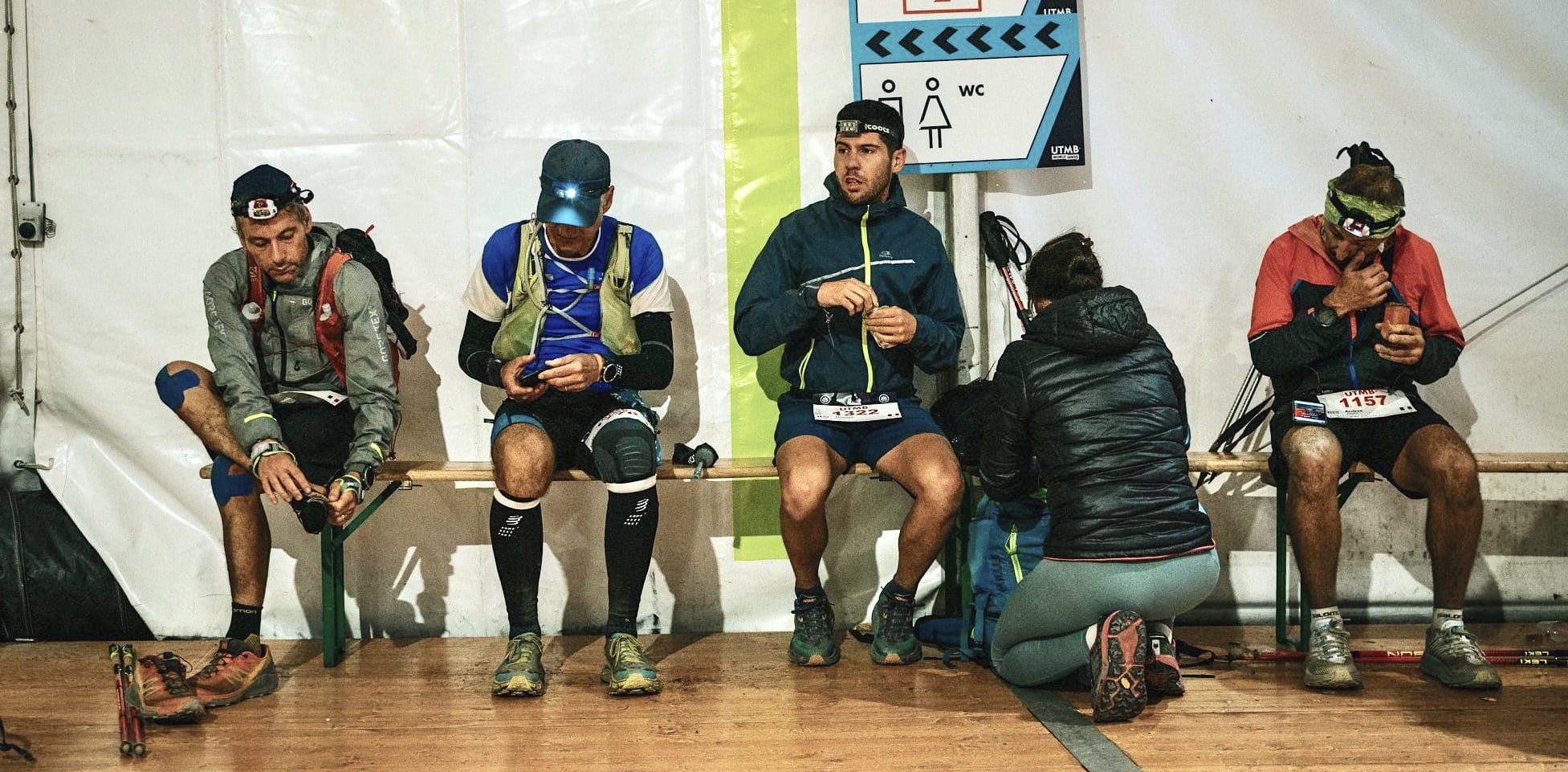
UTMB runners at aid station refueling, organizing gear and checking feet.
Your goal is to get in and get out as quickly and efficiently as possible. During a pit stop, the pit crew complete a number of tasks. At an aid station you must also complete specific tasks to keep moving forward.
Having a clear and simple aid station strategy is essential in terms of your overall performance, particularly later in the race when you’re tired.
Race profile and location of aid stations
UTMB provides an incredible amount of information about each race.
Have you checked out the UTMB Runner Guide?
The race profiles and time charts:
- detail the location of each aid station.
- identify drink only, and food and drink aid stations.
- note if a drop bag is available.
- highlight where crew assistance is permitted.
- give distance between each aid station.
- show the elevation gain and loss between each aid station.
- clearly note cut off times.
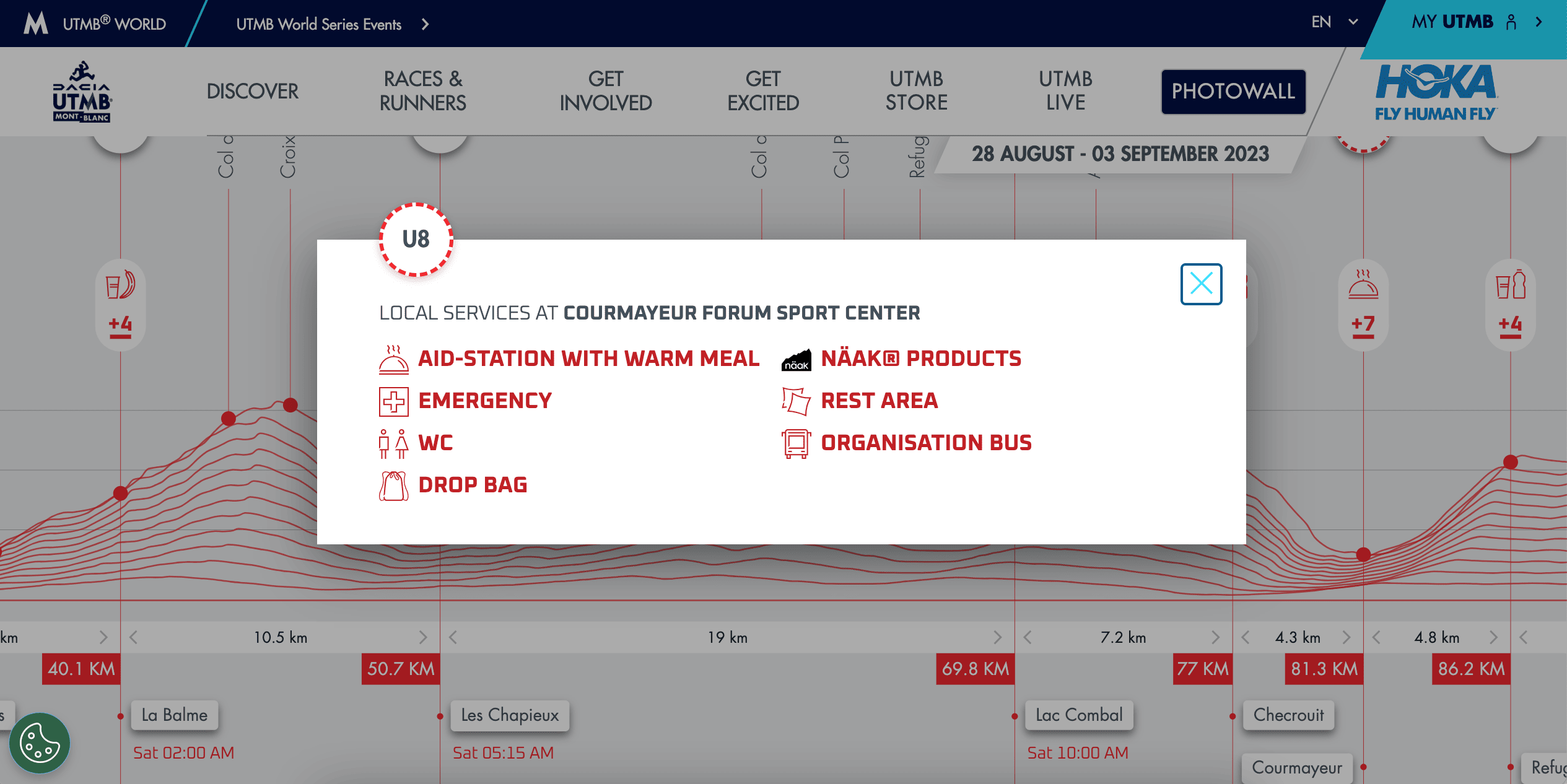
UTMB aid station profile showing services at Courmayeur aid station, and in the background the distances between aid stations and cut-off times.
Make sure you read the highly visible signage boards when you leave each aid station that tell you the distance and time to the next aid station; the cut-off time; and whether food and/or drink will be served there.
– Claire
2. How to plan a successful UTMB aid station strategy
Before race day, you will have studied the race profile and have a grasp of the aid station names, locations and distance between each stop, along with elevation change.
The first part of your race strategy is estimate how long you will take to run the race, and then anticipate how long it will take you to get between aid stations considering the distance, elevation change and terrain.
Tip: You can put your times on a small print out of the race profile; create a neat table, list the aid stations and your estimated times; or write them on the back of your race number, plus how long you plan to spend at each aid station.
Give your crew a copy, then put yours in a sealable bag or laminate it for weatherproofing, and carry it with you.
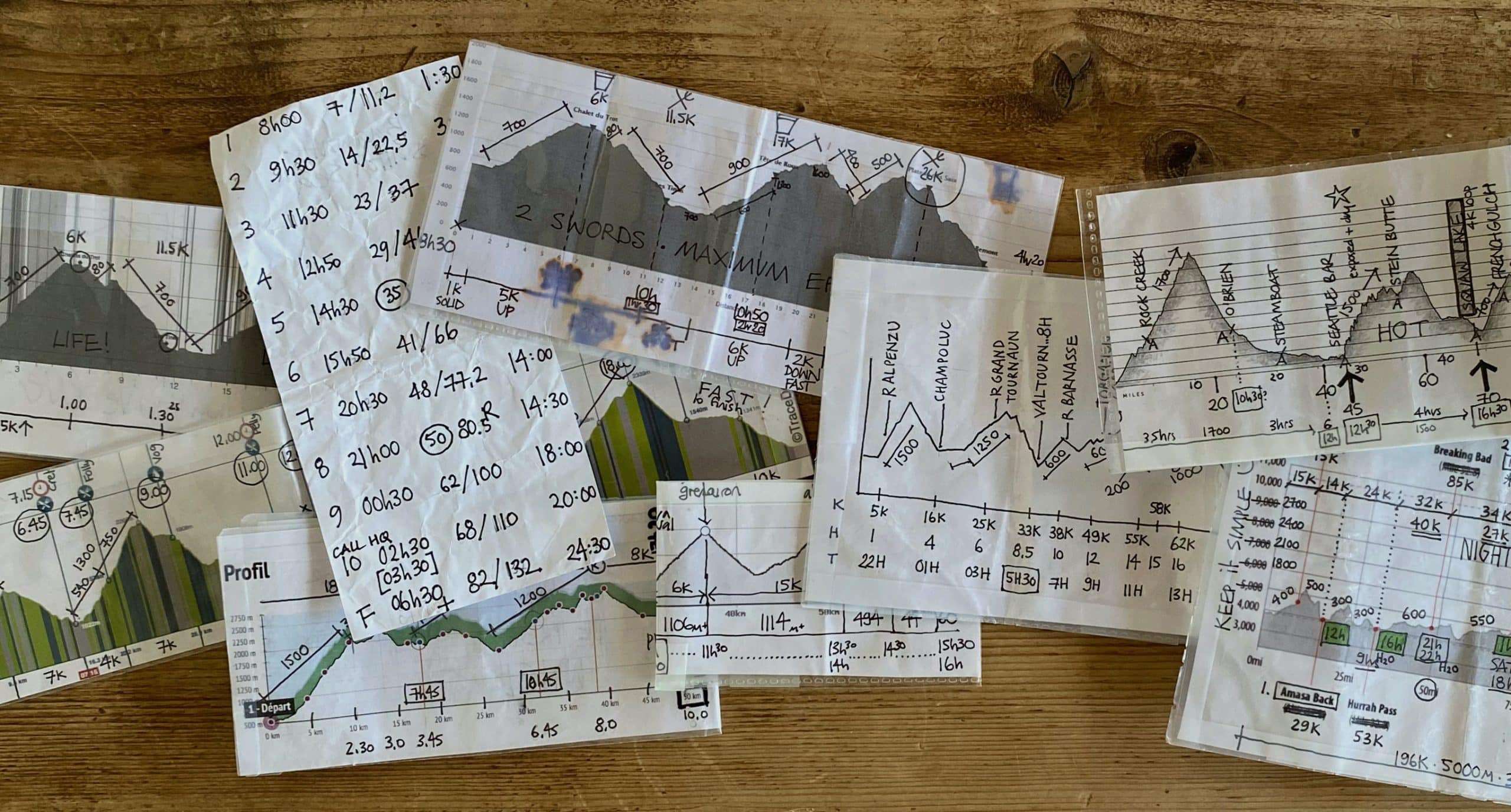
Profiles for different races with distances, elevation change, aid station arrival times and duration of stops.
How do you plan to use each aid station?
Let’s keep this simple.
You have 3 elements to bring awareness to in an aid station, the same as when you’re running.
- Fuel and hydration
- Gear
- Head-to-toe check
How long you are going to be at an aid station?
Whether you have crew or not, your longer stops are likely to be at the larger aid stations where crew are allowed.
In the UTMB and TDS, Courmayeur and Beaufort respectively, are where you can access your drop bags.
Take advantage of the facilities at these aid stations as they are in sports centres and have chairs, mats to sleep on, and toilet facilities. It may be you decide to stop for 20-40 mins.
Courmayeur was buzzing with teams of people relieved to see their athlete in one piece. The aid station was busy with people seeing to our needs, while we fed, changed clothes, popped blisters and quickly off-loaded stories from out on the trail.
– Emilie
The reason for having an aid station plan is so you know, in advance, what you are going to do when you get to an aid station, and you are not trying to make decisions when you are tired.
Make a plan. Stick to it as best possible, then be prepared to adapt if something unexpected happens.
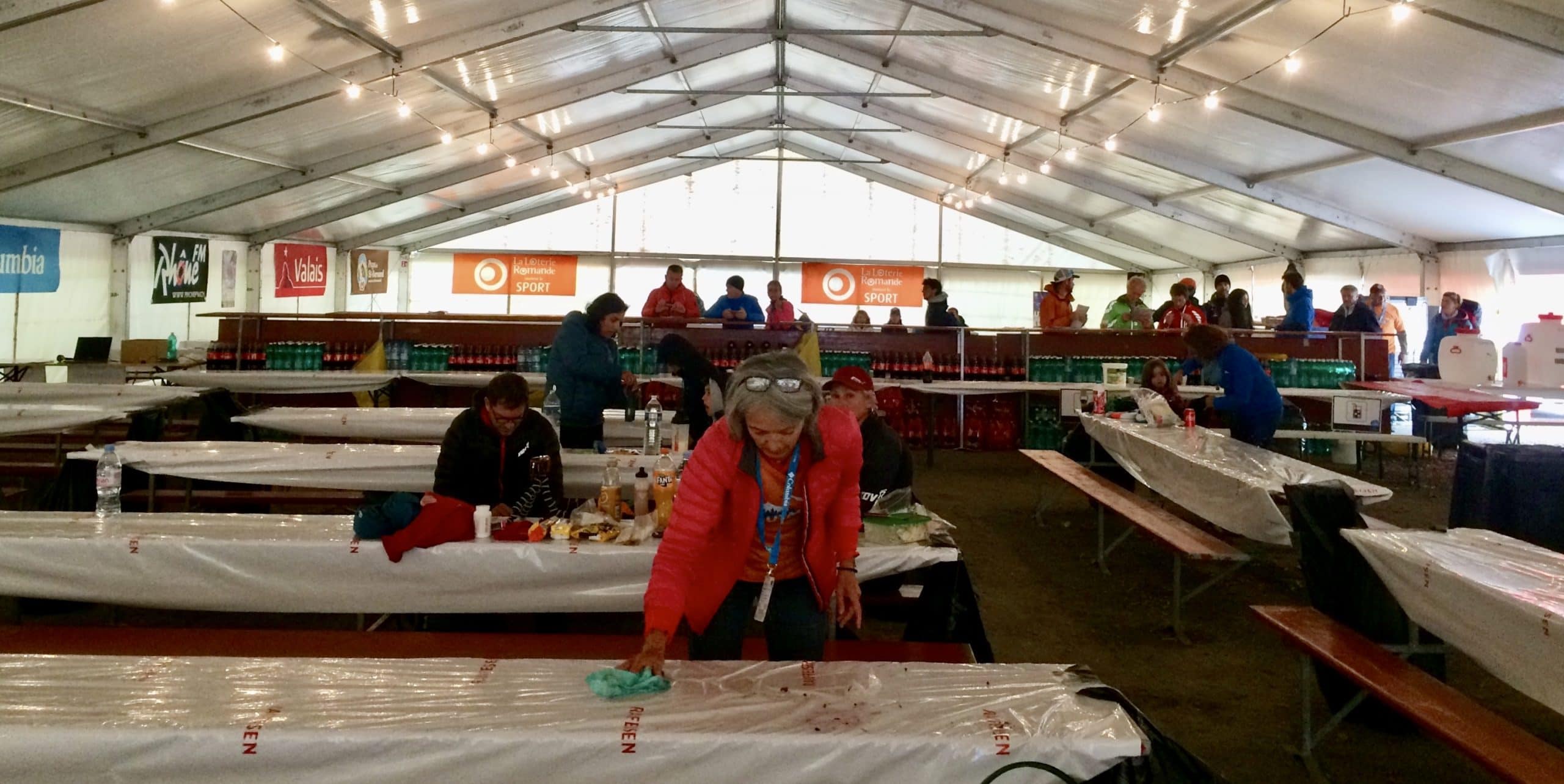
UTMB aid station in Champex-Lac ready for runners to arrive.
You’re in the race.
- When you are 10-20 mins from an aid station, start assessing how you are doing and what you need.
- Check your race strategy. How long have you planned to stop at the next aid station?
- Do a head-to-toe check. Do you need to get grit out of your shoes? Do you have a hot spot, blister or chaffing that need attention?
- Have your trash ready to dispose of when you see a bin.
- When you get to an aid station, try and remember to note your arrival time. It is easy to lose time when you stop.
- Bring focus to eating and drinking. If there’s a bottleneck at the food area, often if you move further down, there is more space.
- What time of day is it? Are you going to need to put your headlamp on ready for the night? Always put your headlamp on before it gets dark.
- Consider the weather conditions and make any gear changes as needed.
- Go through your aid station checklist.
- Feeling great? Awesome! Fill up with water, stock up with food and get out of there!
These tips should help you navigate even the busiest of aid stations with structure and purpose.


TDS aid station in Beaufort at a peak time during the race.
3. What you can expect at UTMB aid stations
There are 2 types of aid station:
- Drinks aid stations.
- Food and drinks aid stations.
Below are the supplies that will be available at each type of aid station.
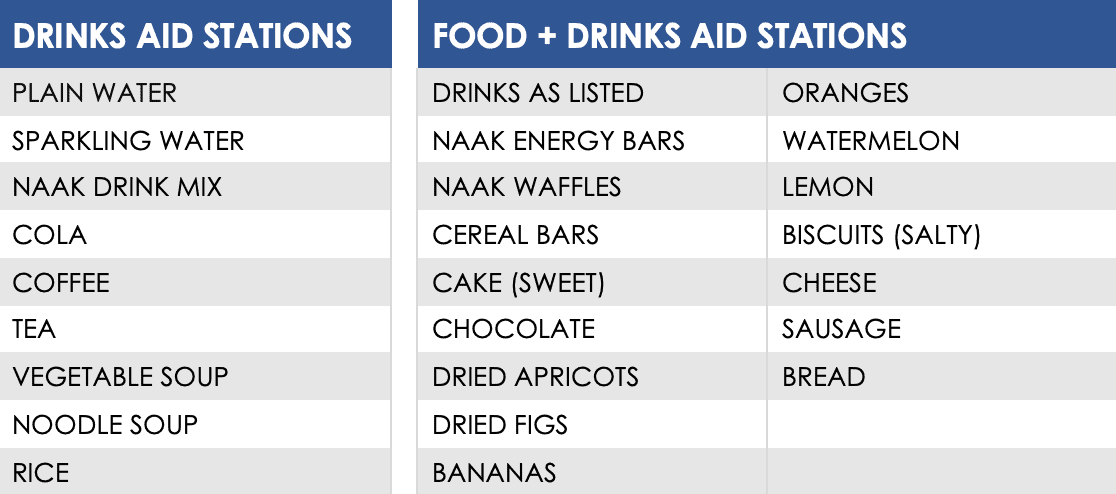
Hot food is available in Les Chapieux and Courmayeur for the UTMB; at Champex-Lac for the UTMB and CCC; and at Beaufort for TDS.
Planning to eat pasta and noodle soup?
Bring your own cup and utensil. To avoid using disposable cups, bowls, and utensils, UTMB requires runners to carry their own.
Your cup should have a minimum capacity of 15cl (bottles and flasks with lids are not acceptable) and we recommend you carry a durable, lightweight camping spoon to eat hot food.
Tip: Find a cup and spoon that fits neatly into a chest or side pocket of your race vest for easy access.
Being able to get to these items quickly when you arrive at an aid station will save you time. Because we’re all about saving you time!
Medical assistance and provisions
Aid stations with medical assistance and provisions are noted on each race profile.
For a serious fall, injury or incident requiring medical attention, seek help as quickly as possible, whether on the trail, or when you arrive at an aid station.
Whilst medical assistance is available at aid stations, you should carry your own small trail running first aid kit and basic blister care supplies, as well as the UTMB obligatory self-adhering bandage for bandaging and strapping (minimum 100 x 6 cm).
The items you carry should help deal with the basic running injuries such as a cut, blister, support for a sprained ankle or muscular strain.
For the UTMB and TDS it is good practice to put extra first aid supplies, particularly blister care products, in a simple sealable bag in your drop bag.
Tip: Keep your trail running first aid kit simple and practical, learn how to deal with blisters and know how to use what you carry. It could just save your race.
What aid stations do not offer
Aid stations do not stock spare gear or clothing. If your poles snap, they snap. Dispose of them at an aid station and carry on with your race, unless you have crew and can pick up a spare set of poles when you next see them. Runners finish UTMB races every year without poles.
Rip your jacket or pants? Drop your headlamp and crack the casing? Duct tape! There are lots of smart ways to use this incredible product.
Tip: Wrap a new length of duct tape around your poles before a race and BAM! You’re ready for anything.
4. UTMB races with or without a crew
UTMB races can be successfully completed without a crew due to the incredible support aid stations provide in terms of food and drink, volunteers, and medical assistance; and the opportunity to have a drop bag mid-race in the UTMB and TDS.
Designated crew aid stations
If you do race with a crew, they are allowed in designated crew aid stations* which are marked on the race profiles of the UTMB, TDS and CCC.
Due to the number of runners, only 1 crew member, with 1 bag (maximum 30 litres) is allowed into the designated area to assist you.
There is an informal waiting area in front of aid stations, where UTMB volunteers will check your progress and estimated arrival time at the aid station, before allowing your crew member into the aid station. Generally, this is 10 mins before you arrive.
*No assistance is allowed during the OCC, MCC, ETC and YCC.
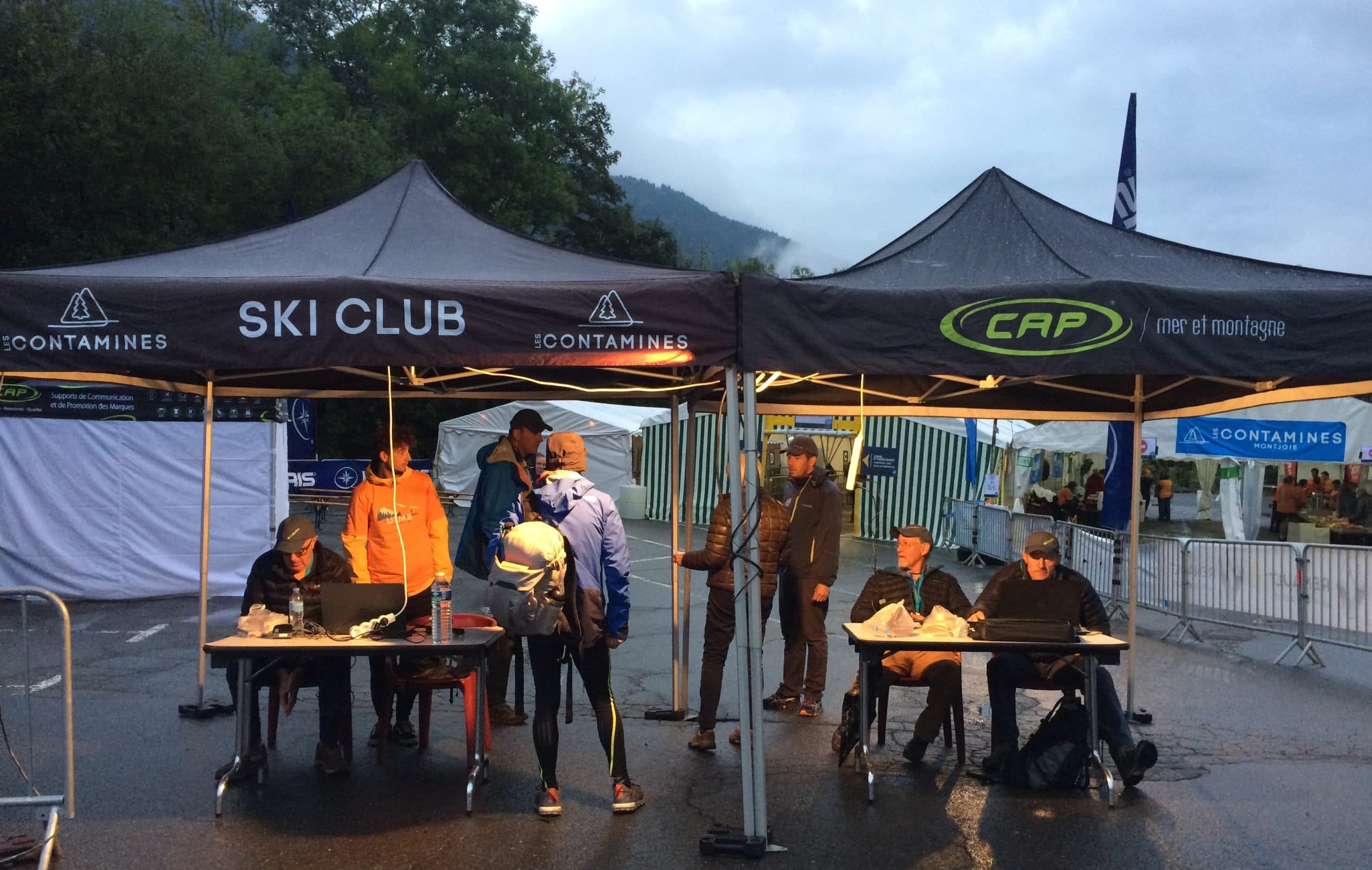
UTMB aid station in les Contamines where volunteers check arrival time of runners before allowing crew members into the aid station.
Pre-race meeting with your crew
A pre-race meeting is valuable for you and your crew. Make it focused and fun.
- Share your race strategy with your crew. This can be as simple as your overall goal for the race and a note of key timings.
- Check that everyone is clear which aid stations crew assistance is permitted, and of these aid stations, which aid stations your crew will be at.
- Talk through each item in your crew bag. A good tip is to include a small towel for your crew to layout your gear on, as when it’s busy it’s easy to misplace items.
- Talk through each item in your drop bag.
- UTMB and TDS drop bag aid stations, Courmayeur and Beaufort respectively, also allow crew. Only you can get your drop bag. Agree that you arrive at the aid station, get your drop bag, and then find your crew member.
- Be aware when aid stations are busy, it can be difficult to find your crew and for your crew to spot you. Stay calm and work your way through the aid station until you see each other.
- Ask your crew member to note the time you arrive at an aid station and to keep a check on it during your stop, so you stay as close to your timings as possible.
- A clear and simple aid station strategy helps everyone. For example, at Courmayeur, I’m going to spend 20 mins and take off my shoes and socks, dry my feet, treat any hot spots or blisters, put on a fresh pair of socks, a new pair of shoes, drink an electrolyte drink, fill my water bottles, eat some pasta, restock my pack with snacks, and then I’m out of there!
- You may decide to have a 15-20 min nap at an aid station. Ask your crew to set an alarm.
- Be ready to adapt when something unexpected happens. This reminder is for you and your crew. Your crew could get stuck in traffic and miss you at an aid station, or you are 2 hrs behind your predicted time because of blisters, and need a longer stop than planned to attend to your feet.
- If your race is not going to plan, make sure your crew always have the cut off times to hand, and can advise you on how long you should stay at a particular aid station. Honesty and clarity are extremely important at times like this in a race.
- Ask your crew if they have any questions.
- Lastly, tell your crew you love them and that you are incredibly grateful for their support and encouragement, and if, during the race, you are quiet, it is nothing they have done.
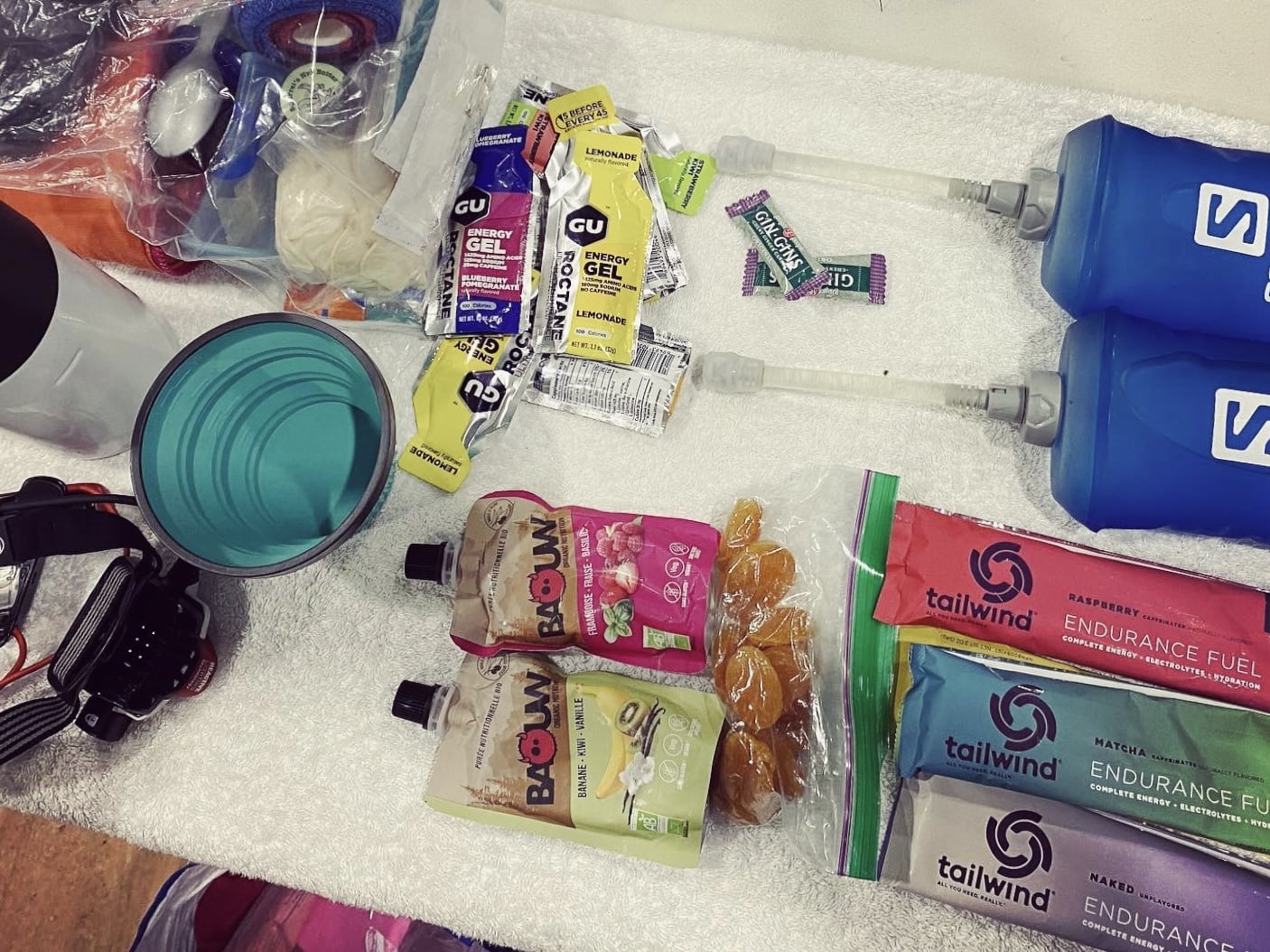
Food and drink laid out by a crew member ready for their runner to arrive. Plus, additional gear and clothing in crew bag.
5. UTMB drop bags
Drop bags give you the opportunity to access items during a race that you don’t have to carry. This could be specific nutrition, a change of clothes, socks, back-up headlamp, first aid kit, even shoes, if the drop bag is big enough.
UTMB rules and regulations
At packet pickup, where you get your race number, 30 litre drop bags are issued for the UTMB (1 bag), TDS (2 bags), CCC (1 bag), OCC (1 bag) and MCC (1 bag) with clear instructions where to leave them.
- UTMB your drop bag is taken to Courmayeur aid station.
- TDS you leave 1 x drop bag in the allotted area near the start, which is returned to Chamonix. Your other drop bag is taken to Beaufort aid station.
- CCC, OCC and MCC you leave 1 x drop bag in the allocated area near the start, which is returned to Chamonix.
- For the ETC you can leave your own bag, near the start, in Courmayeur.
It is important to note:
- only drop bags supplied by UTMB will be transported.
- poles are not allowed in drop bags.
- drop bags are not checked or controlled, so do not put valuable items in them.
Planning and organizing an effective drop bag
A carefully planned drop bag can reset your race, give comfort in the form of a much-needed pair of dry socks, or a foot care bag that helps you finish your UTMB race.
My first race with a drop bag was the CCC* and it rained (or snowed) for the entire race. I ran with my girlfriend, and when we collected our drop bags, we became aware of 2 guys next to us. They took out towels, a change of clothes, socks, even shoes from their drop bags before purposefully heading back out into the storm.
We started laughing because we knew exactly what was in our drop bags: a pair of socks and a Cliff Bar. That was it.
– John
The difference a well thought out drop bag, over a poorly planned one, cannot be overstated.
Never underestimate, within reason, what you may need during a race. The key is to pack smart. Know what aid stations offer in terms of nutrition and hydration, and pack items you think you may need over this.
Tip: Running without crew? Put a checklist in your drop bag to ensure you do the tasks you plan to do at that aid station.
You can also write an inspiring quote or mantra on your drop bag note to give you a motivational boost and supercharge the rest of your race.
*The CCC no longer has a mid-race drop bag.
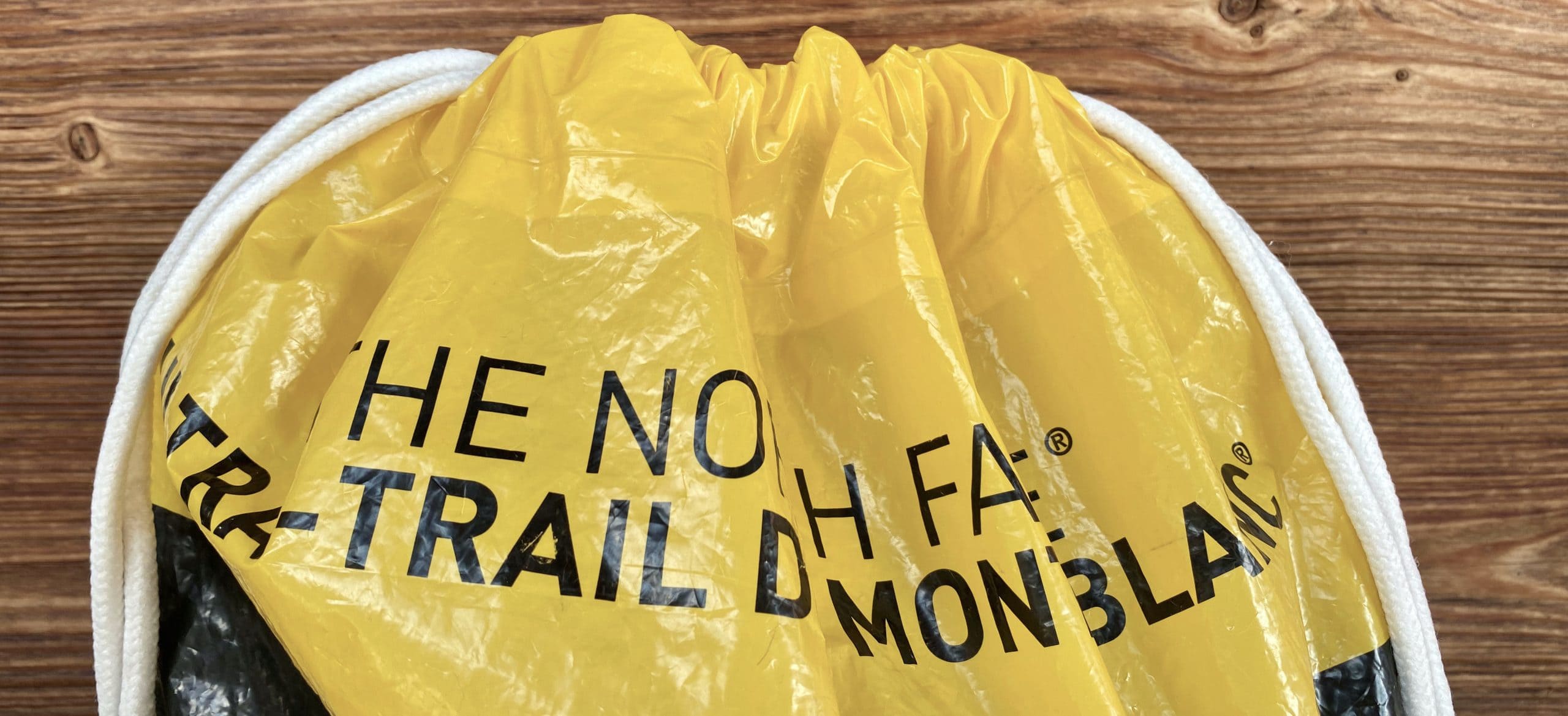
UTMB drop bag when The North Face were event sponsors.
6. The power of kindness in running a better race
Kindness matters.
The aid station volunteers are cafeteria lunch servers, cheerleaders and nurses all rolled into one.
– Claire
When we arrive at an aid station, we could be running our best race, or we could be deep in the pain cave running our worst race.
Volunteers are amazing, however they will not know which type of race you’re having. Be kind.
A simple smile, whether it’s cheery or weary, can relay the message that you are grateful and appreciative, and from a volunteer, a smile says welcome, I care.
UTMB races exist because of the teams of volunteers who give their time to ensure you are supported, as best possible, during your race, often going above and beyond their duties to help keep you moving.
So, when you are at an aid station, take a minute to acknowledge a volunteer and thank them for their help.
Because a simple act of kindness can have a big impact on the volunteer and you.
Summary
The longer into my race I got, the faster the aid stations seemed to arrive. And that really helped the time to fly.
– Emilie
Aid stations are the perfect way to celebrate progress on your journey to becoming a UTMB finisher.
From nutrition to motivation, aid stations boost morale and bring focus to your performance. Get in, complete your pit stop tasks, and get out as effortlessly as possible.
So, celebrate each aid station. Smile. Self-high five. You’ve got this.
See you in Chamonix!
Thank you for reading.
About Dr Kaz Williams
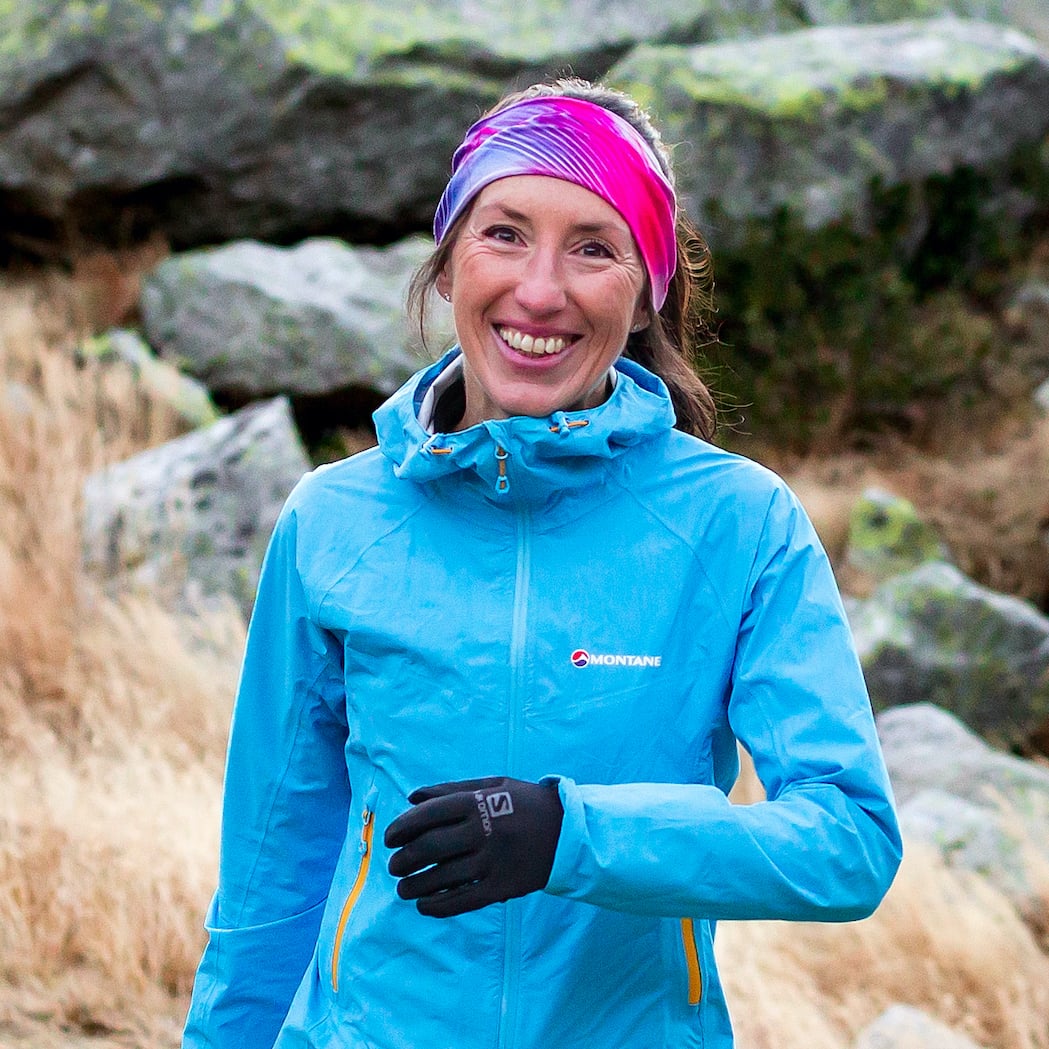
Hi, I’m Kaz, Mettle founder, Performance Psychologist, Coach and Speaker, supporting trail and ultra runners, like you, reach your goals. Based in Chamonix, with strong US trail running connections, our mission is simple: to take your fitness, training and mental game to a new level of running success.
We’d love to hear from you. Message us to arrange a call so we can learn about your running ambitions and help you reach them.


